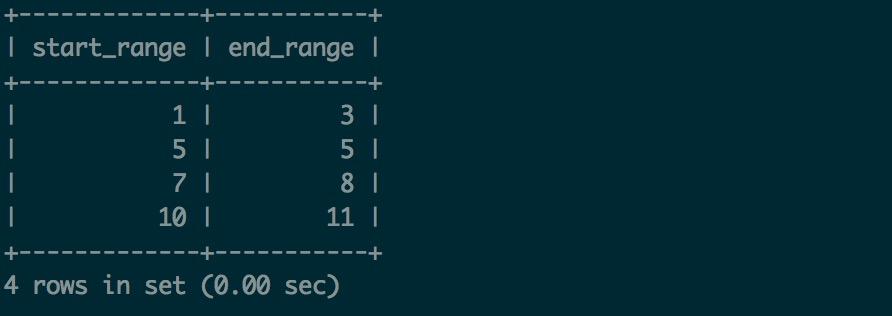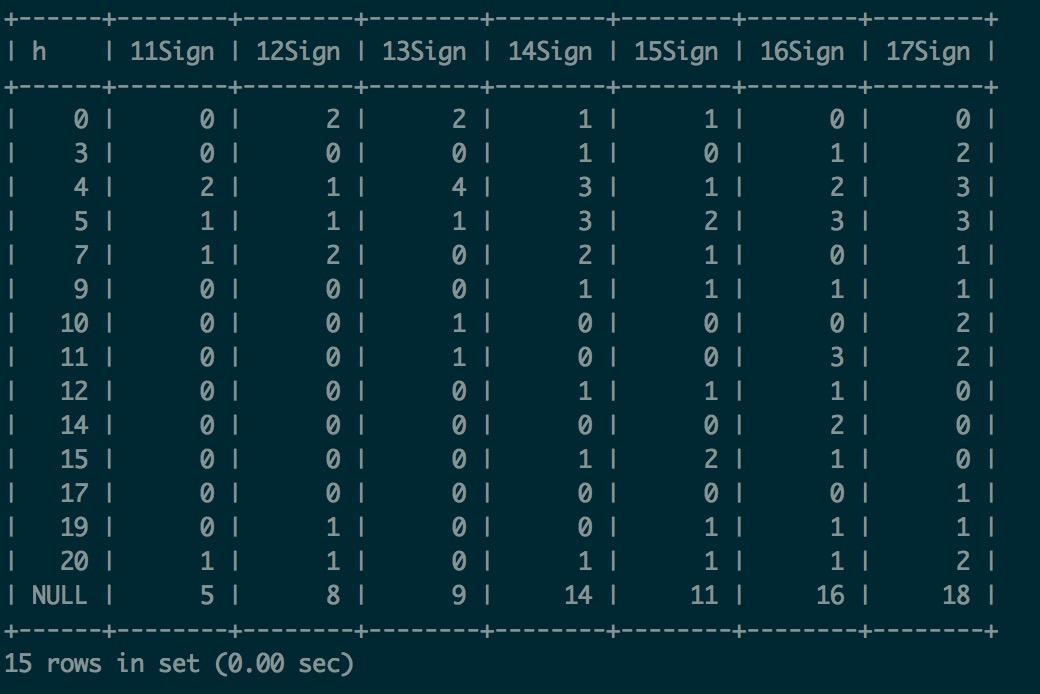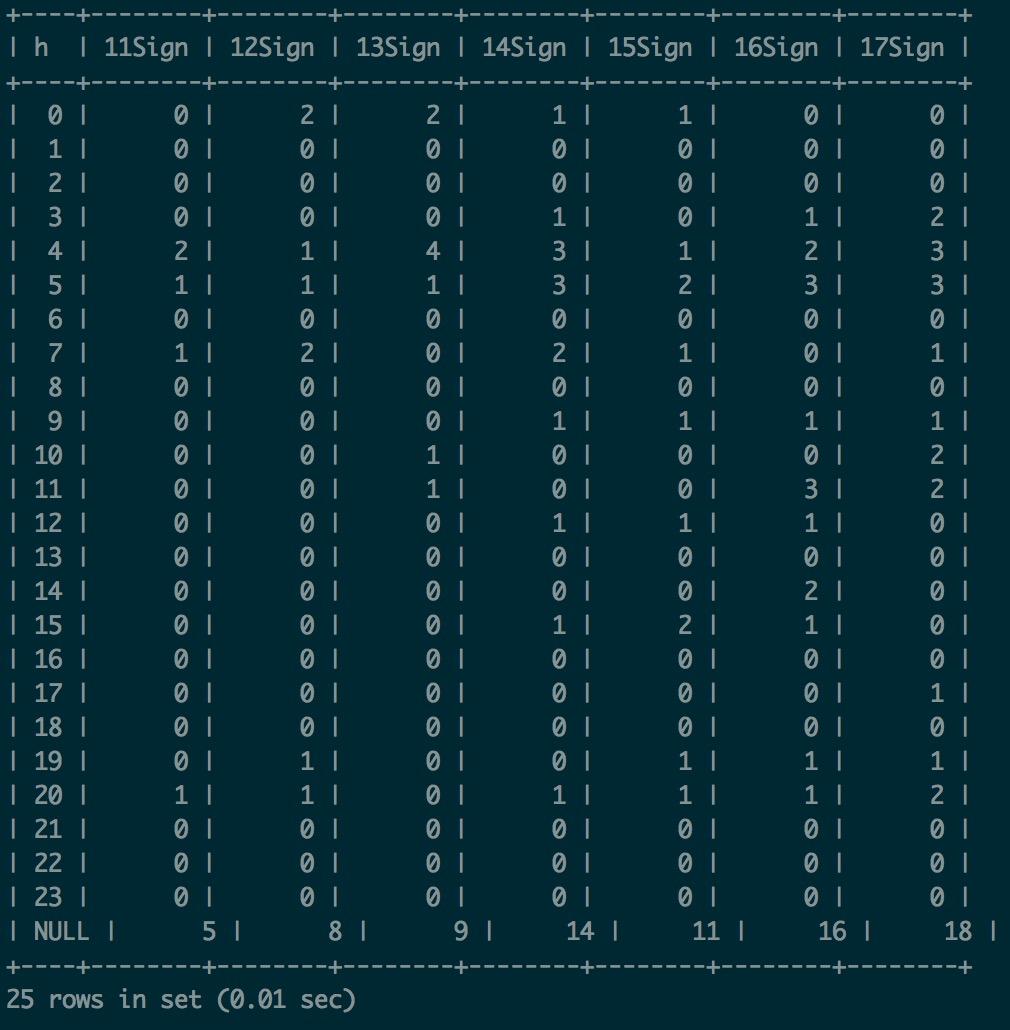Mysql 常用SQL语句集锦
来源:互联网 发布:导入isp数据库 编辑:程序博客网 时间:2024/05/01 01:18
基础篇
//查询时间,友好提示$sql = "select date_format(create_time, '%Y-%m-%d') as day from table_name";//int 时间戳类型$sql = "select from_unixtime(create_time, '%Y-%m-%d') as day from table_name";//一个sql返回多个总数$sql = "select count(*) all, " ;$sql .= " count(case when status = 1 then status end) status_1_num, ";$sql .= " count(case when status = 2 then status end) status_2_num ";$sql .= " from table_name";//Update Join / Delete Join$sql = "update table_name_1 ";$sql .= " inner join table_name_2 on table_name_1.id = table_name_2.uid ";$sql .= " inner join table_name_3 on table_name_3.id = table_name_1.tid ";$sql .= " set *** = *** ";$sql .= " where *** ";//delete join 同上。//替换某字段的内容的语句$sql = "update table_name set content = REPLACE(content, 'aaa', 'bbb') ";$sql .= " where (content like '%aaa%')";//获取表中某字段包含某字符串的数据$sql = "SELECT * FROM `表名` WHERE LOCATE('关键字', 字段名) ";//获取字段中的前4位$sql = "SELECT SUBSTRING(字段名,1,4) FROM 表名 ";//查找表中多余的重复记录//单个字段$sql = "select * from 表名 where 字段名 in ";$sql .= "(select 字段名 from 表名 group by 字段名 having count(字段名) > 1 )";//多个字段$sql = "select * from 表名 别名 where (别名.字段1,别名.字段2) in ";$sql .= "(select 字段1,字段2 from 表名 group by 字段1,字段2 having count(*) > 1 )";//删除表中多余的重复记录(留id最小)//单个字段$sql = "delete from 表名 where 字段名 in ";$sql .= "(select 字段名 from 表名 group by 字段名 having count(字段名) > 1) ";$sql .= "and 主键ID not in ";$sql .= "(select min(主键ID) from 表名 group by 字段名 having count(字段名 )>1) ";//多个字段$sql = "delete from 表名 别名 where (别名.字段1,别名.字段2) in ";$sql .= "(select 字段1,字段2 from 表名 group by 字段1,字段2 having count(*) > 1) ";$sql .= "and 主键ID not in ";$sql .= "(select min(主键ID) from 表名 group by 字段1,字段2 having count(*)>1) ";业务篇
连续范围问题
//创建测试表CREATE TABLE `test_number` ( `id` int(10) unsigned NOT NULL AUTO_INCREMENT, `number` int(11) unsigned NOT NULL DEFAULT '0' COMMENT '数字', PRIMARY KEY (`id`)) ENGINE=InnoDB DEFAULT CHARSET=utf8//创建测试数据insert into test_number values(1,1);insert into test_number values(2,2);insert into test_number values(3,3);insert into test_number values(4,5);insert into test_number values(5,7);insert into test_number values(6,8);insert into test_number values(7,10);insert into test_number values(8,11);实验目标:求数字的连续范围。
根据上面的数据,应该得到的范围。
1-35-57-810-11//执行Sqlselect min(number) start_range,max(number) end_rangefrom( select number,rn,number-rn diff from ( select number,@number:=@number+1 rn from test_number,(select @number:=0) as number ) b) c group by diff;签到问题
//创建参考表(模拟数据需要用到)CREATE TABLE `test_nums` ( `id` int(11) unsigned NOT NULL AUTO_INCREMENT, PRIMARY KEY (`id`)) ENGINE=InnoDB DEFAULT CHARSET=utf8 COMMENT='参考表';//模拟数据,插入 1-10000 连续数据.//创建测试表CREATE TABLE `test_sign_history` ( `id` int(10) unsigned NOT NULL AUTO_INCREMENT, `uid` int(11) unsigned NOT NULL DEFAULT '0' COMMENT '用户ID', `create_time` timestamp NOT NULL DEFAULT CURRENT_TIMESTAMP COMMENT '签到时间', PRIMARY KEY (`id`)) ENGINE=InnoDB DEFAULT CHARSET=utf8 COMMENT='签到历史表';//创建测试数据insert into test_sign_history(uid,create_time)select ceil(rand()*10000),str_to_date('2016-12-11','%Y-%m-%d')+interval ceil(rand()*10000) minutefrom test_nums where id<31;//统计每天的每小时用户签到情况select h, sum(case when create_time='2016-12-11' then c else 0 end) 11Sign, sum(case when create_time='2016-12-12' then c else 0 end) 12Sign, sum(case when create_time='2016-12-13' then c else 0 end) 13Sign, sum(case when create_time='2016-12-14' then c else 0 end) 14Sign, sum(case when create_time='2016-12-15' then c else 0 end) 15Sign, sum(case when create_time='2016-12-16' then c else 0 end) 16Sign, sum(case when create_time='2016-12-17' then c else 0 end) 17Signfrom( select date_format(create_time,'%Y-%m-%d') create_time, hour(create_time) h, count(*) c from test_sign_history group by date_format(create_time,'%Y-%m-%d'), hour(create_time)) agroup by h with rollup;//统计每天的每小时用户签到情况(当某个小时没有数据时,显示0)select h , sum(case when create_time='2016-12-11' then c else 0 end) 11Sign, sum(case when create_time='2016-12-12' then c else 0 end) 12Sign, sum(case when create_time='2016-12-13' then c else 0 end) 13Sign, sum(case when create_time='2016-12-14' then c else 0 end) 14Sign, sum(case when create_time='2016-12-15' then c else 0 end) 15Sign, sum(case when create_time='2016-12-16' then c else 0 end) 16Sign, sum(case when create_time='2016-12-17' then c else 0 end) 17Signfrom( select b.h h,c.create_time,c.c from ( select id-1 h from test_nums where id<=24 ) b left join ( select date_format(create_time,'%Y-%m-%d') create_time, hour(create_time) h, count(*) c from test_sign_history group by date_format(create_time,'%Y-%m-%d'), hour(create_time) ) c on (b.h=c.h)) agroup by h with rollup;//统计每天的用户签到数据和每天的增量数据select type, sum(case when create_time='2016-12-11' then c else 0 end) 11Sign, sum(case when create_time='2016-12-12' then c else 0 end) 12Sign, sum(case when create_time='2016-12-13' then c else 0 end) 13Sign, sum(case when create_time='2016-12-14' then c else 0 end) 14Sign, sum(case when create_time='2016-12-15' then c else 0 end) 15Sign, sum(case when create_time='2016-12-16' then c else 0 end) 16Sign, sum(case when create_time='2016-12-17' then c else 0 end) 17Signfrom( select b.create_time,ifnull(b.c-c.c,0) c,'Increment' type from ( select date_format(create_time,'%Y-%m-%d') create_time, count(*) c from test_sign_history group by date_format(create_time,'%Y-%m-%d') ) b left join ( select date_format(create_time,'%Y-%m-%d') create_time, count(*) c from test_sign_history group by date_format(create_time,'%Y-%m-%d') ) c on(b.create_time=c.create_time+ interval 1 day) union all select date_format(create_time,'%Y-%m-%d') create_time, count(*) c, 'Current' from test_sign_history group by date_format(create_time,'%Y-%m-%d')) agroup by typeorder by case when type='Current' then 1 else 0 end desc;//模拟不同的用户签到了不同的天数insert into test_sign_history(uid,create_time)select uid,create_time + interval ceil(rand()*10) day from test_sign_history,test_numswhere test_nums.id <10 order by rand() limit 150;//统计签到天数相同的用户数量select sum(case when day=1 then cn else 0 end) 1Day, sum(case when day=2 then cn else 0 end) 2Day, sum(case when day=3 then cn else 0 end) 3Day, sum(case when day=4 then cn else 0 end) 4Day, sum(case when day=5 then cn else 0 end) 5Day, sum(case when day=6 then cn else 0 end) 6Day, sum(case when day=7 then cn else 0 end) 7Day, sum(case when day=8 then cn else 0 end) 8Day, sum(case when day=9 then cn else 0 end) 9Day, sum(case when day=10 then cn else 0 end) 10Dayfrom( select c day,count(*) cn from ( select uid,count(*) c from test_sign_history group by uid ) a group by c) b;//统计每个用户的连续签到时间select * from ( select d.*, @ggid := @cggid, @cggid := d.uid, if(@ggid = @cggid, @grank := @grank + 1, @grank := 1) grank from ( select uid,min(c.create_time) begin_date ,max(c.create_time) end_date,count(*) count from ( select b.*, @gid := @cgid, @cgid := b.uid, if(@gid = @cgid, @rank := @rank + 1, @rank := 1) rank, b.diff-@rank flag from ( select distinct uid, date_format(create_time,'%Y-%m-%d') create_time, datediff(create_time,now()) diff from test_sign_history order by uid,create_time ) b, (SELECT @gid := 1, @cgid := 1, @rank := 1) as a ) c group by uid,flag order by uid,count(*) desc ) d,(SELECT @ggid := 1, @cggid := 1, @grank := 1) as e)fwhere grank=1;如果大家需要下载上述的相关数据表,进行测试。
可以关注微信公众号,回复 “签到数据表”,即可获取数据表。
本文地址: http://blog.csdn.net/aerchi/article/details/53735077
0 0
- Mysql 常用SQL语句集锦
- Mysql 常用 SQL 语句集锦
- Mysql 常用 SQL 语句集锦
- Mysql 常用SQL语句集锦
- Mysql 常用SQL语句集锦
- Mysql 常用 SQL 语句集锦
- Mysql常用SQL语句集锦
- Mysql常用SQL语句集锦
- Mysql 常用SQL语句集锦
- sql常用语句集锦
- sql常用语句集锦
- 常用SQL语句集锦
- mysql常用语句集锦
- mysql常用语句集锦
- MySQL常用语句集锦
- MySQL常用语句集锦
- Mysql常用语句集锦
- mysql sql语句集锦
- Caffe中的反向传播代码理解
- unity 实现pageView翻页效果
- UDP传输小实验
- C序列化或反序列化库tpl
- sql语句- 查询 本月 本周 等相关数据
- Mysql 常用SQL语句集锦
- kafka相关命令
- FileZilla
- 459. Repeated Substring Pattern
- css中的position
- php system和exec区别
- Java语法糖的味道:泛型与类型擦除
- thinkphp打印任意执行的sql语句
- while(true)循环与CPU占用率问题








